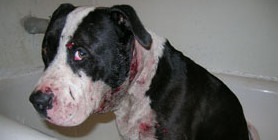This unfortunate dog was injured in a dog fight.
We need to stop this abuse of animals…NOW!
1.. What is dogfighting?
Dogfighting is a sadistic “contest” in which two dogs—specifically bred, conditioned, and trained to fight—are placed in a pit (generally a small arena enclosed by plywood walls) to fight each other for the spectators’ entertainment and gambling. Fights average nearly an hour in length and often last more than two hours. Dogfights end when one of the dogs will not or cannot continue. In addition to these dogfights, there are reports of an increase in unorganized street fights in urban areas.
2. How does it cause animal suffering?
The injuries inflicted and sustained by dogs participating in dogfights are frequently severe, even fatal. The American pit bull terriers used in the majority of these fights have been specifically bred and trained for fighting and are unrelenting in their attempts to overcome their opponents. With their extremely powerful jaws, they are able to inflict severe bruising, deep puncture wounds and broken bones.
Dogs used in these events often die of blood loss, shock, dehydration, exhaustion, or infection hours or even days after the fight. Other animals are often sacrificed as well. Some owners train their dogs for fights using smaller animals such as cats, rabbits or small dogs. These “bait” animals are often stolen pets or animals obtained through “free to good home” advertisements.
3. Are there other concerns?
Yes. Numerous law enforcement raids have unearthed many disturbing facets of this illegal “sport.” Young children are sometimes present at the events, which can promote insensitivity to animal suffering, enthusiasm for violence and a lack of respect for the law. Illegal gambling is the norm at dogfights. Dog owners and spectators wager thousands of dollars on their favorites. Firearms and other weapons have been found at dogfights because of the large amounts of cash present. And dogfighting has been connected to other kinds of violence—even homicide, according to newspaper reports. In addition, illegal drugs are often sold and used at dogfights.
4. What other effects does the presence of dogfighting have on people and animals in a community?
Dogs used for fighting have been bred for many generations to be dangerously aggressive toward other animals. The presence of these dogs in a community increases the risk of attacks not only on other animals but also on people. Children are especially at risk, because their small size may cause a fighting dog to perceive a child as another animal.
5. Why should dogfighting be a felony offense?
There are several compelling reasons. Because dogfighting yields such large profits for participants, the minor penalties associated with misdemeanor convictions are not a sufficient deterrent. Dogfighters merely absorb these fines as part of the cost of doing business. The cruelty inherent in dogfighting should be punished by more than a slap on the hand. Dogfighting is not a spur-of-the-moment act; it is a premeditated and cruel practice.
Those involved in dogfighting go to extensive lengths to avoid detection by law enforcement, so investigations can be difficult, dangerous, and expensive. Law enforcement officials are more inclined to investigate dogfighting if it is a felony. As more states make dogfighting a felony offense, those remaining states with low penalties will become magnets for dogfighters.
6. Do some states already have felony laws?
Yes. Dogfighting is illegal in all 50 states and a felony offense in almost every state.
7. Should being a spectator also be a felony?
Yes. Spectators provide much of the profit associated with dogfighting. The money generated by admission fees and gambling helps keep this “sport” alive. Because dogfights are illegal and therefore not widely publicized, spectators do not merely happen upon a fight; they seek it out. They are willing participants who support a criminal activity through their paid admission and attendance.
8. What can I do to help stop dogfighting?
If you live in one of the states where dogfighting is still only a misdemeanor, please write to your state legislators and urge them to make it a felony. To find out how your state treats dogfighting, visit the link for State Dogfighting Laws.
We encourage you also to write letters to the media to increase public awareness of the dangers of dogfighting and to law enforcement officials or prosecutors and judges to urge them to take the issue seriously.
If you suspect that dogfighting is going on in your own neighborhood, alert your local law enforcement agency and urge your local government agency officials to act.
How to Spot Signs of Dogfighting in Your Community
An inordinate number of pit bulls being kept in one location, especially multiple dogs who are chained and seem unsocialized.
Dogs with scars on their faces, front legs and stifle area (hind end and thighs).
Dogfighting training equipment such as treadmills used to build dogs’ endurance “break sticks” used to pry apart the jaws of dogs locked in battle tires or “springpoles” (usually a large spring with rope attached to either end) hanging from tree limbs .
Unusual foot traffic coming and going from a location at odd hours.
Updated August 24, 2007



